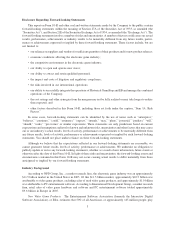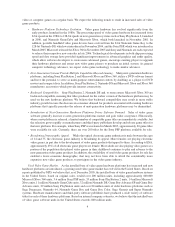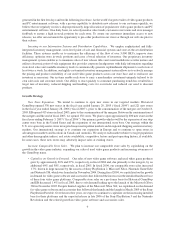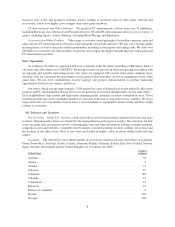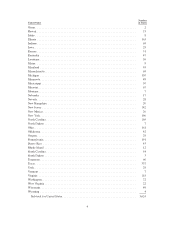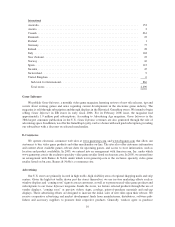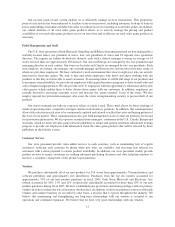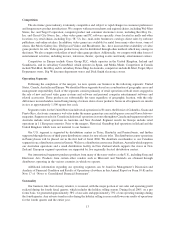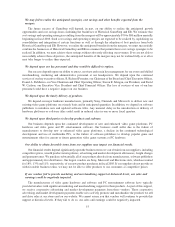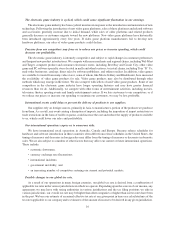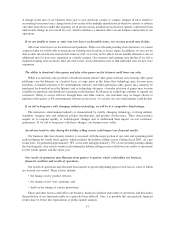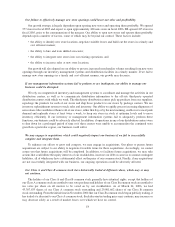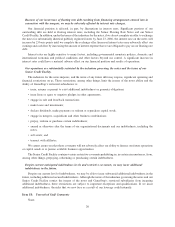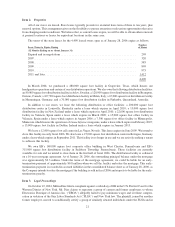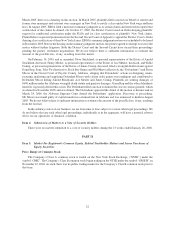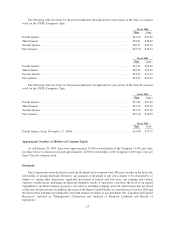GameStop 2005 Annual Report Download - page 22
Download and view the complete annual report
Please find page 22 of the 2005 GameStop annual report below. You can navigate through the pages in the report by either clicking on the pages listed below, or by using the keyword search tool below to find specific information within the annual report.Competition
The electronic game industry is intensely competitive and subject to rapid changes in consumer preferences
and frequent new product introductions. We compete with mass merchants and regional chains, including Wal-Mart
Stores, Inc. and Target Corporation; computer product and consumer electronics stores, including Best Buy Co.,
Inc. and Circuit City Stores, Inc.; other video game and PC software specialty stores located in malls and other
locations; toy retail chains, including Toys “R” Us, Inc.; mail-order businesses; catalogs; direct sales by software
publishers; and online retailers. In addition, video games are available for rental from many video stores, some of
whom, like Movie Gallery Inc. (Hollywood Video) and Blockbuster, Inc., have increased the availability of video
game products for sale. Video game products may also be distributed through other methods which may emerge in
the future. We also compete with sellers of used video game products. Additionally, we compete with other forms of
entertainment activities, including movies, television, theater, sporting events and family entertainment centers.
Competitors in Europe include Game Group PLC, which operates in the United Kingdom, Ireland and
Scandinavia, and its subsidiary CentroMail, which operates in Spain, and Media Markt. Competitors in Canada
include Wal-Mart, Best Buy and its subsidiary Future Shop. In Australia, competitors include K-Mart, Target, Myer
Department stores, Big W discount department stores and Dick Smith electronics stores.
Operating Segments
Following the completion of the mergers, we now operate our business in the following segments: United
States, Canada, Australia and Europe. We identified these segments based on a combination of geographic areas and
management responsibility. Each of the segments consists primarily of retail operations with all stores engaged in
the sale of new and used video game systems and software and personal computer entertainment software and
related accessories. These products are substantially the same regardless of geographic location, with the only
differences in merchandise carried being timing of release dates of new products. Stores in all segments are similar
in size at approximately 1,500 square feet each.
Segment results for the United States include retail operations in 50 states, the District of Columbia, Guam and
Puerto Rico, electronic commerce web sites under the names gamestop.com and ebgames.com and Game Informer
magazine. Segment results for Canada include retail operations in stores throughout Canada and segment results for
Australia include retail operations in Australia and New Zealand. Segment results for Europe include retail
operations in 11 European countries. Prior to the mergers, Historical GameStop had operations in Ireland and the
United Kingdom which were not material to our business.
Our U.S. segment is supported by distribution centers in Texas, Kentucky and Pennsylvania, and further
supported through the use of third-party distribution centers for new release titles. The distribution center operations
in Pennsylvania will be phased out in the first half of fiscal 2006. We distribute merchandise to our Canadian
segment from a distribution center in Ontario. We have a distribution center near Brisbane, Australia which supports
our Australian operations and a small distribution facility in New Zealand which supports the stores in New
Zealand. European segment operations are supported by five regionally-located distribution centers.
Our international segments purchase products from many of the same vendors as the U.S., including Sony and
Electronic Arts. Products from certain other vendors such as Microsoft and Nintendo are obtained through
distributors operating in the various countries in which we operate.
Additional information regarding our operating segments can be found in Management’s Discussion and
Analysis of Financial Condition and Results of Operations elsewhere in this Annual Report on Form 10-K and in
Note 17 of “Notes to Consolidated Financial Statements”.
Seasonality
Our business, like that of many retailers, is seasonal, with the major portion of our sales and operating profit
realized during the fourth fiscal quarter, which includes the holiday selling season. During fiscal 2005, on a pro
forma basis, we generated approximately 38% of our sales and approximately 75% of our operating earnings during
the fourth quarter. Any adverse trend in sales during the holiday selling season could lower our results of operations
for the fourth quarter and the entire year.
13


